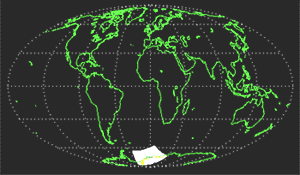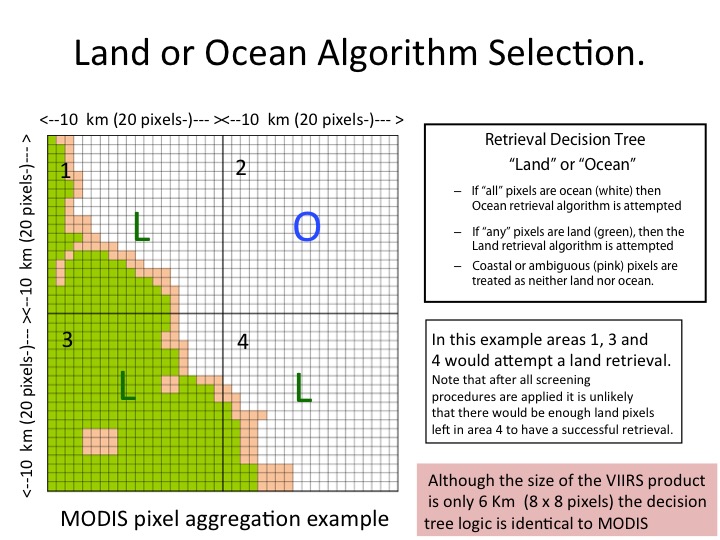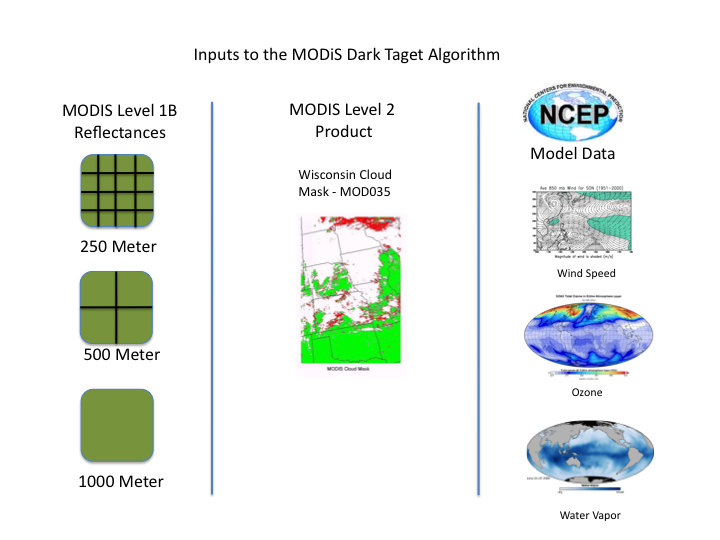Inputs to the aerosol retrieval
The MODIS data files are made available as 5-minute segements from each orbit which are called ‘granules’. Each granule covers an area of about 2030 km along the orbital path and 2330 km (swath width) perpendicular to the oribital path.

The animation at left illustrates the relative size and shape of the MODIS granules for a single orbit. Global coverage is obtained each day except for small gaps near the equator. Note that the locations of the granules change each day in conjunction with the changing location of the satellite's 16 day orbial cycle.
The pixels comprising the data files are at a nominal 1 km resolution at nadir view. Note, that due to spherical geometry, the size of each pixel increases from 1 km at nadir to nearly 4 km at the swath edges. Each input granule is 1354 by 2030 pixels in this ‘1 km’ resolution. Only data from MODIS daytime orbits are considered for retrieval.
VIIRS Modifications
VIIRS aerosol product data files are made available as 6 minutes granules. The swath width perpendicular to the orbital path is 3040 Km which is considerably wider than MODIS. As a result VIIRS does not have gaps between swaths near the equator.
VIIRS has a 16-day orbital repeat cycle, that is, the spacecraft will observe the earth from the same geometry every 16 days. The entire globe is observed in 14 daily overpasses.
Nadir pixels are 0.75 Km with the size increasing to ~ 1.2 Km at the edge of the swath.
The product files are 405 x 400 pixels.
Both the land and ocean aerosol algorithms rely on calibrated, geolocated reflectances (known as ‘Level 1B’ or ‘L1B’) provided by the MODIS Characterization Support Team (MCST). These are identified as products MOD02 and MOD03 for Terra and MYD02 and MYD03 for Aqua. Note that since the Terra satellite has the longer historical record from here onward our description of the algorithm will refer to the Terra "MOD" files but all Aqua files and products use "MYD" in the file or product name.
The algorithm actually uses L1B reflectances at three resolutions (MOD021KM, MOD02HKM and MOD02QKM for 1 km, 500 m and 250 m resolution channels, respectively). In addition, the MODIS algorithm uses the processed geophysical product (known as ‘Level 2’ or "L2 for short) MOD35 Wisconsin cloud mask product (Ackerman et al. 1998). Finally, the algorithm expects ancillary data from NCEP (National Center for Environmental Prediction) analyses, including the (closest to granule time) GDAS1 1°x1° 6 hourly meteorological analysis for water vapor, wind speed and ozone profiles. In past versions of the product the TOVS (before 2005) or the TOAST (after 2005) 1°x1° daily ozone analysis were used as inputs. Although the algorithm inputs NCEP data, when it is not available at the time of processing climatological data from NCEP is used for first guess water vapor, wind speeds,and ozone profiles.
VIIRS Modifications
Both the land and ocean aerosol algorithms rely on lower level Intermediate Format Files (IFF) which are processed at the University of Wisconsin (see next VIIRS box for more information).
The NASA DT algorithm uses the MVCM upstream cloud product which is very similar to the MODIS MOD35. See this link for additional MCVM details.
NCEP data is used to provide ancillary input data using the same methodology as for MODIS (see preceding MODIS paragraph).
Processing prior to aerosol retrieval
The aerosol algorithm reads in the required L1B, L2 and ancillary data into memory. Specifically, for the 10 km retrieval, it reads one scan line at a time, where each scan is made up of ten 1km pixels along track. The 1354 swath pixels are also collected into ten pixel boxes, so that there are 135 - ’10 km’ boxes in a swath. Each of these boxes is separately considered for aerosol retrieval.
Note that each 10 km box contains 10 x 10 = 100 ‘1 km’ pixels and 20 x 20 = 400 ‘500 m’ pixels. Again note that these sizes refer to the nadir view. At the scan edges the number of pixels in each box remains the same, but the area encompassed in each box will be much larger than the area encompassed at nadir. MODIS product size near the edge of the swath is ~ 40 Km
Reflectances in all seven MODIS-aerosol channels, plus the 1.38 µm channel are corrected for water vapor, ozone and carbon dioxide. In addition to the cloud mask, the M?D03 geolocation product also classifies each pixel as ‘land’, ‘ephemeral water’, ‘coastal’, ‘shallow inland water’, ‘deep inland water’, ‘shallow ocean’, ‘moderate ocean’ or ‘deep ocean’.

If all pixels in the 10 km box are considered water (‘deep inland water’, ‘shallow ocean’, ‘moderate ocean’ or ‘deep ocean’), the algorithm proceeds with the over-ocean retrieval.
However, if any pixel is considered non-water, then it proceeds with the over-land algorithm.
If more than 50% of the pixels with a box are classified as ‘ephemeral water’, ‘coastal’, or ‘shallow inland water’, the algorithm will proceed with the land algorithm, but the retrieval will be assigned a low quality.
VIIRS Modifications
Lower level data files for VIIRS (analagous to the level 1B files used to create the MODIS product) are known as Intermediate Format Files (IFF). Geolocation information is embedded in the IFF data. IFF granule file size is 3200 x 3232 pixels all of which are at 0.75 Km resolution.

The entire granule is read into the system and then processed to product 6 Km retrieval sized pixels. There are 405 6 Km pixels boxes in a swath.
The VIIRS DT aerosol products are retrieved at 6 x 6 Km. At left is a comparison of the MODIS and VIIRS products near nadir. At the end of the swath VIIRS product size expands to ~ 10x10 Km.
The number of pixels aggregated into the VIIRS product is 8 x 8 = 64 total pixels. This is independent of the location in the swath.
The decision tree for land or ocean retrieval is identical to that described for MODIS in the text and image above the only difference being in the number of pixels

